Types of Leadership Theories and Their Impacts on Business
VerifiedAdded on 2023/01/19
|12
|2637
|85
AI Summary
This study explores different types of leadership theories, including situational leadership, participative leadership, and contingency theory. It discusses the positive and negative impacts of these theories on business. The study highlights the importance of leadership in achieving organizational goals and motivating employees.
Contribute Materials
Your contribution can guide someone’s learning journey. Share your
documents today.
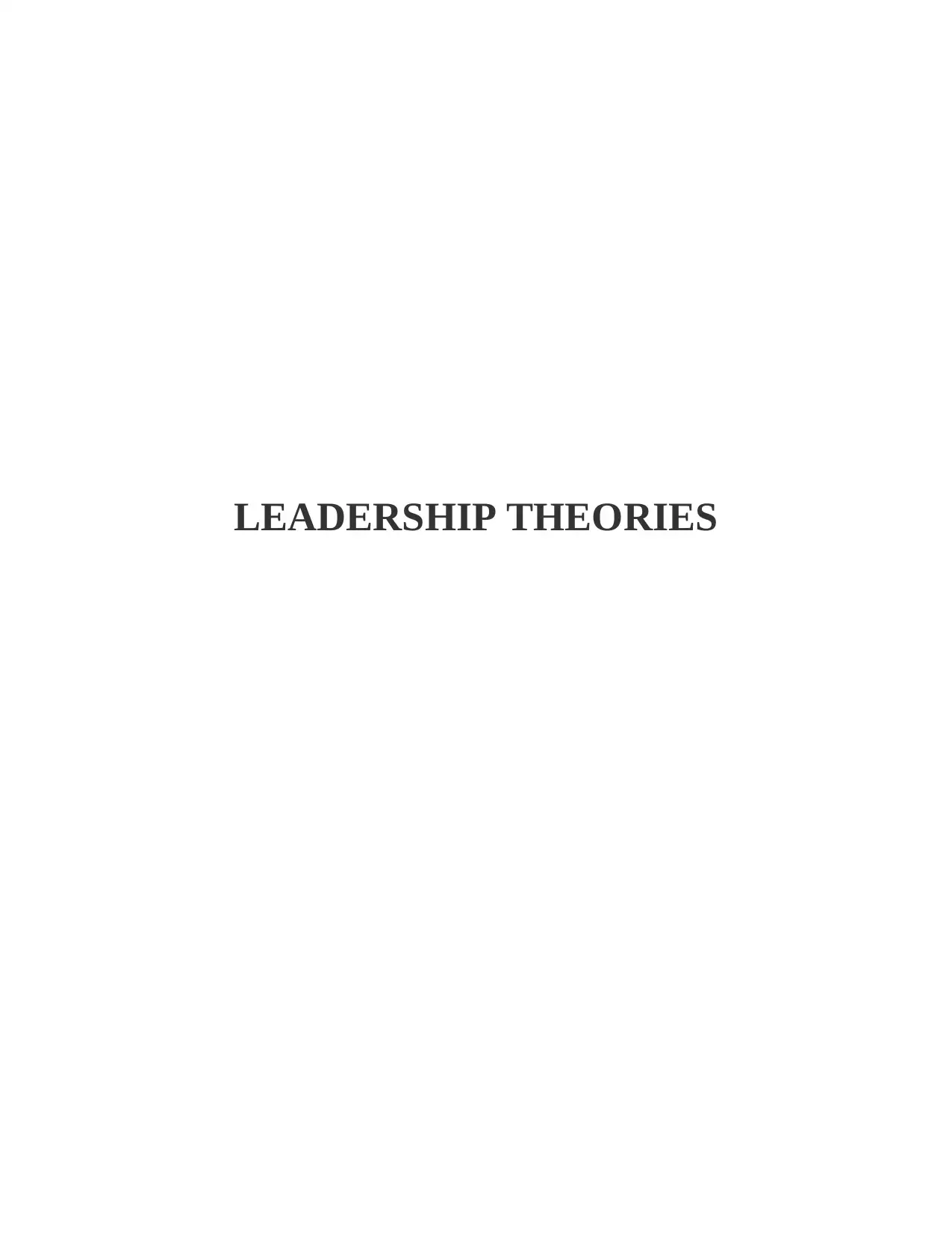
LEADERSHIP THEORIES
Secure Best Marks with AI Grader
Need help grading? Try our AI Grader for instant feedback on your assignments.
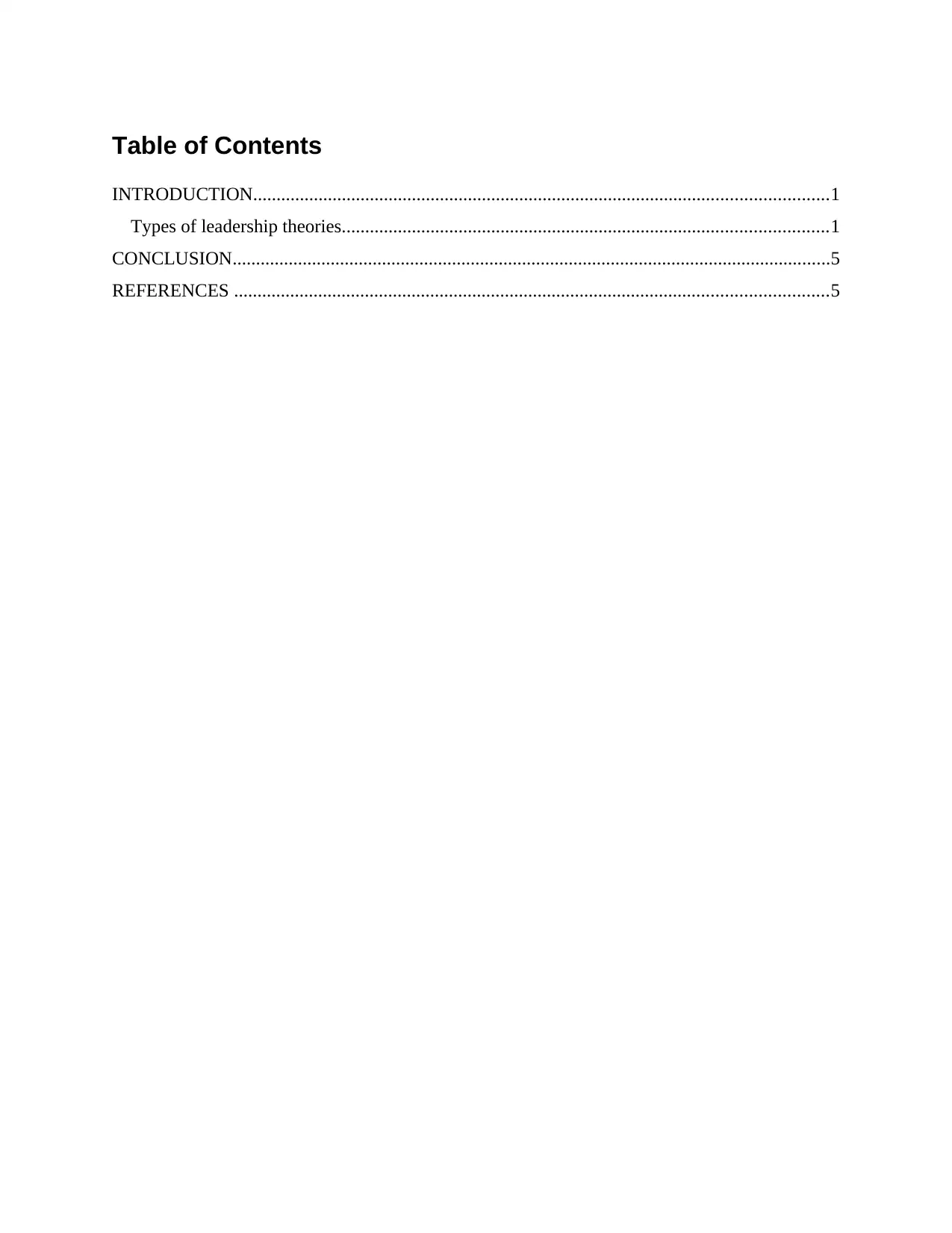
Table of Contents
INTRODUCTION...........................................................................................................................1
Types of leadership theories........................................................................................................1
CONCLUSION................................................................................................................................5
REFERENCES ...............................................................................................................................5
INTRODUCTION...........................................................................................................................1
Types of leadership theories........................................................................................................1
CONCLUSION................................................................................................................................5
REFERENCES ...............................................................................................................................5

INTRODUCTION
Leaderships is an art used for motivating a group or workers to act for achieving an
common goal. Leadership is an practice by which an administrator can guide, direct and
influence the behaviours of people at workplace. It is the role of leader to develop future visions
for organisation and motivates the staff members for achieving the goal. Leadership theories are
the schools made to give recommendation to become successful leaders (Carnes, Houghton and
Ellison, 2015). The study will highlight the different types of theories (situational leadership,
participative leadership & contingency theory) and their positive and negatives impacts on
business.
ASSESSMENT
Types of leadership theories.
Leadership theories are the institutions of thoughts made to explain that how opne can
become successful leaders. Leadership theories lays emphasis on behaviour and traits which
individual can adopt to enhance their self leadership capabilities Gümüsay, 2019).
Situational leadership theory
As per the view of the author Amanchukwu, Stanley and Ololube, (2015) this theory says
that the style of leadership depends upon the situation in the organisation. This theory refers to
those types of leaders who changes their leadership style according to the condition and the level
of development of their group members. The author says that it is an very effective way of
leadership because it accepts the needs of teams and sets a fruitful balance for whole business.
This leadership theory is a model which is invented by Paul Hersey and Ken Blanchard. In year
1969 this theory was first introduced as “ Life cycle theory of leadership”. And in year 1970s the
life cycle theory is renamed as “Situational leadership theory”. This theory is also referred to
Hersey- Blanchard situational leadership theory. The author Amanchukwu, Stanley and Ololube,
(2015) argues that this leadership my not be suitable to those organisations who are task oriented
or have highly regimented managers. Some aspects of leadership theory is very difficult to define
and quantifying maturity, in this model maturity is referring to both job maturity and emotional
maturity and this some times results in an conflation between two.
1
Leaderships is an art used for motivating a group or workers to act for achieving an
common goal. Leadership is an practice by which an administrator can guide, direct and
influence the behaviours of people at workplace. It is the role of leader to develop future visions
for organisation and motivates the staff members for achieving the goal. Leadership theories are
the schools made to give recommendation to become successful leaders (Carnes, Houghton and
Ellison, 2015). The study will highlight the different types of theories (situational leadership,
participative leadership & contingency theory) and their positive and negatives impacts on
business.
ASSESSMENT
Types of leadership theories.
Leadership theories are the institutions of thoughts made to explain that how opne can
become successful leaders. Leadership theories lays emphasis on behaviour and traits which
individual can adopt to enhance their self leadership capabilities Gümüsay, 2019).
Situational leadership theory
As per the view of the author Amanchukwu, Stanley and Ololube, (2015) this theory says
that the style of leadership depends upon the situation in the organisation. This theory refers to
those types of leaders who changes their leadership style according to the condition and the level
of development of their group members. The author says that it is an very effective way of
leadership because it accepts the needs of teams and sets a fruitful balance for whole business.
This leadership theory is a model which is invented by Paul Hersey and Ken Blanchard. In year
1969 this theory was first introduced as “ Life cycle theory of leadership”. And in year 1970s the
life cycle theory is renamed as “Situational leadership theory”. This theory is also referred to
Hersey- Blanchard situational leadership theory. The author Amanchukwu, Stanley and Ololube,
(2015) argues that this leadership my not be suitable to those organisations who are task oriented
or have highly regimented managers. Some aspects of leadership theory is very difficult to define
and quantifying maturity, in this model maturity is referring to both job maturity and emotional
maturity and this some times results in an conflation between two.
1

The leaders can move from one style to other, deepening upon the situation, the nature of
work to be performed and workers maturity. The benefit of this leadership style is that it creates
an comfortable environment for the staff as leaders makes efforts to create an style which is
based on readiness level of the group or the needs of the group members. The author
Amanchukwu, Stanley and Ololube, (2015) contradicts that this style focuses more on immediate
requirements rather than long term needs. As instead of being focused on overall objectives, the
situational leaders fall in the trap where they only focuses on evaluating and responding to the
immediate needs all the time.
As per the view of author Amanchukwu, Stanley and Ololube, (2015) this leadership
style takes various phases of development into account. As instead of putting all the workers in
an same category the manger looks the situation of each leader individually. The goal of the
leader is to analyse the competency of single workers individually, and assist in boosting
motivation level of the employee based on the style which are best suitable for them. The author
Carnes, Houghton and Ellison, (2015) argues that Situational leaders also have skills similar to
others employees. If the leaders has capability to adopt to understand the changes in situation and
what are the requirements of people, then only they can be beneficial for their role. If this skill of
the manager is not very well developed then their reactions will not be very much effective. The
author Clapp-Smith and et.al., (2019) says that this theory is very popular and used very
frequently to training the managers within the business. This theory is highly practical and very
easy to understand, it is an sensible theory and can be applicable to variety of situations and
settings. The author argues that Carnes, Houghton and Ellison, (2015) as it is not very easy to
make changes in leadership style it requires proper analyses of organisation's situations and it is
very time consuming procedure.
Contingency theory
The contingency theory is organisational theory which claims that there os not any best
way for organising an corporation, for making effective decisions and leading a company, It is
somewhat similar to the situational leadership theory as a contingent leader apply their own
leadership style which is best suitable for the situation. The contingency theory of leadership was
made by was developed by Austrian psychologist Fred Edward Fielder in 1964. This theory lays
emphasis on the importance of leaders personality as well as conditions in which they operates.
2
work to be performed and workers maturity. The benefit of this leadership style is that it creates
an comfortable environment for the staff as leaders makes efforts to create an style which is
based on readiness level of the group or the needs of the group members. The author
Amanchukwu, Stanley and Ololube, (2015) contradicts that this style focuses more on immediate
requirements rather than long term needs. As instead of being focused on overall objectives, the
situational leaders fall in the trap where they only focuses on evaluating and responding to the
immediate needs all the time.
As per the view of author Amanchukwu, Stanley and Ololube, (2015) this leadership
style takes various phases of development into account. As instead of putting all the workers in
an same category the manger looks the situation of each leader individually. The goal of the
leader is to analyse the competency of single workers individually, and assist in boosting
motivation level of the employee based on the style which are best suitable for them. The author
Carnes, Houghton and Ellison, (2015) argues that Situational leaders also have skills similar to
others employees. If the leaders has capability to adopt to understand the changes in situation and
what are the requirements of people, then only they can be beneficial for their role. If this skill of
the manager is not very well developed then their reactions will not be very much effective. The
author Clapp-Smith and et.al., (2019) says that this theory is very popular and used very
frequently to training the managers within the business. This theory is highly practical and very
easy to understand, it is an sensible theory and can be applicable to variety of situations and
settings. The author argues that Carnes, Houghton and Ellison, (2015) as it is not very easy to
make changes in leadership style it requires proper analyses of organisation's situations and it is
very time consuming procedure.
Contingency theory
The contingency theory is organisational theory which claims that there os not any best
way for organising an corporation, for making effective decisions and leading a company, It is
somewhat similar to the situational leadership theory as a contingent leader apply their own
leadership style which is best suitable for the situation. The contingency theory of leadership was
made by was developed by Austrian psychologist Fred Edward Fielder in 1964. This theory lays
emphasis on the importance of leaders personality as well as conditions in which they operates.
2
Secure Best Marks with AI Grader
Need help grading? Try our AI Grader for instant feedback on your assignments.
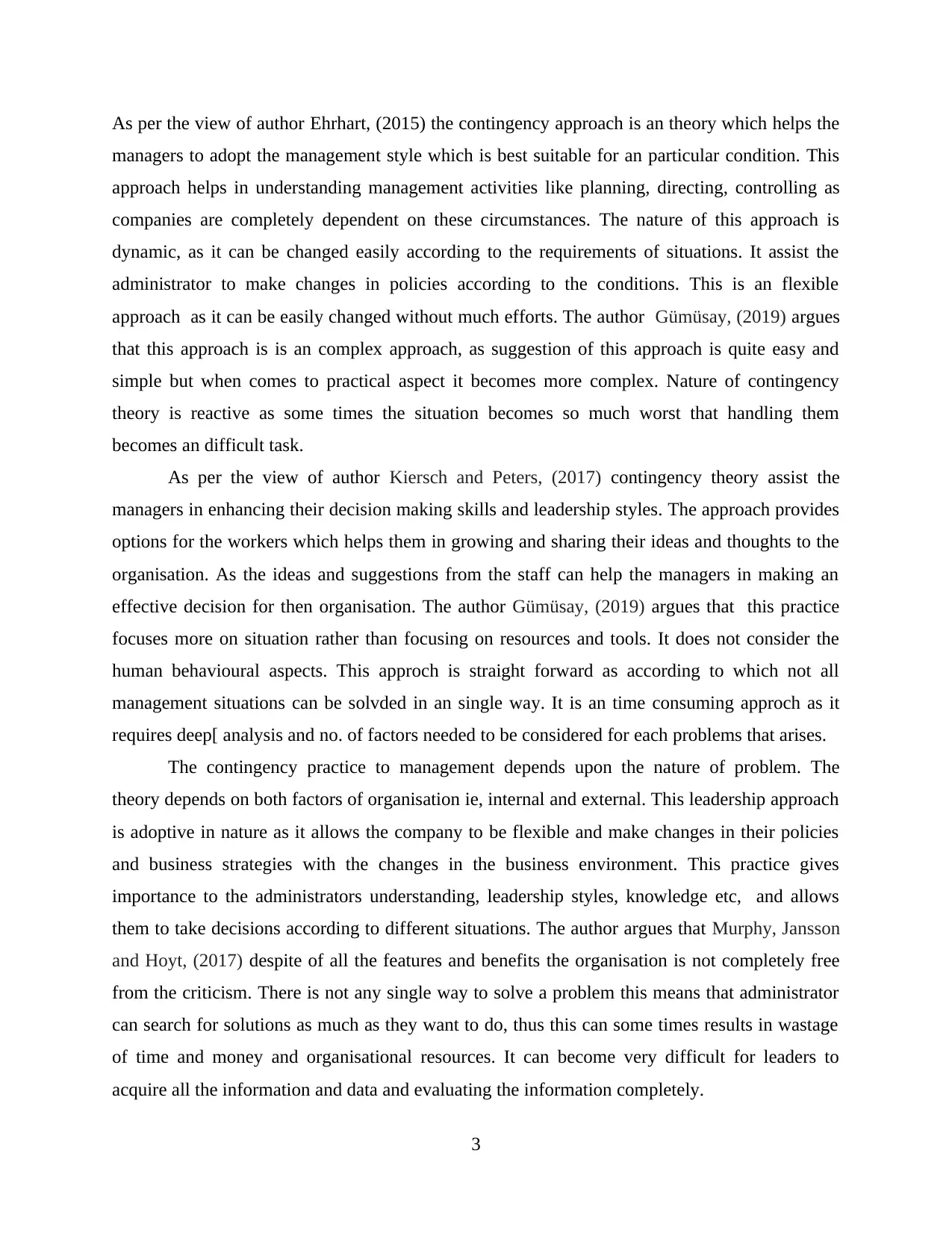
As per the view of author Ehrhart, (2015) the contingency approach is an theory which helps the
managers to adopt the management style which is best suitable for an particular condition. This
approach helps in understanding management activities like planning, directing, controlling as
companies are completely dependent on these circumstances. The nature of this approach is
dynamic, as it can be changed easily according to the requirements of situations. It assist the
administrator to make changes in policies according to the conditions. This is an flexible
approach as it can be easily changed without much efforts. The author Gümüsay, (2019) argues
that this approach is is an complex approach, as suggestion of this approach is quite easy and
simple but when comes to practical aspect it becomes more complex. Nature of contingency
theory is reactive as some times the situation becomes so much worst that handling them
becomes an difficult task.
As per the view of author Kiersch and Peters, (2017) contingency theory assist the
managers in enhancing their decision making skills and leadership styles. The approach provides
options for the workers which helps them in growing and sharing their ideas and thoughts to the
organisation. As the ideas and suggestions from the staff can help the managers in making an
effective decision for then organisation. The author Gümüsay, (2019) argues that this practice
focuses more on situation rather than focusing on resources and tools. It does not consider the
human behavioural aspects. This approch is straight forward as according to which not all
management situations can be solvded in an single way. It is an time consuming approch as it
requires deep[ analysis and no. of factors needed to be considered for each problems that arises.
The contingency practice to management depends upon the nature of problem. The
theory depends on both factors of organisation ie, internal and external. This leadership approach
is adoptive in nature as it allows the company to be flexible and make changes in their policies
and business strategies with the changes in the business environment. This practice gives
importance to the administrators understanding, leadership styles, knowledge etc, and allows
them to take decisions according to different situations. The author argues that Murphy, Jansson
and Hoyt, (2017) despite of all the features and benefits the organisation is not completely free
from the criticism. There is not any single way to solve a problem this means that administrator
can search for solutions as much as they want to do, thus this can some times results in wastage
of time and money and organisational resources. It can become very difficult for leaders to
acquire all the information and data and evaluating the information completely.
3
managers to adopt the management style which is best suitable for an particular condition. This
approach helps in understanding management activities like planning, directing, controlling as
companies are completely dependent on these circumstances. The nature of this approach is
dynamic, as it can be changed easily according to the requirements of situations. It assist the
administrator to make changes in policies according to the conditions. This is an flexible
approach as it can be easily changed without much efforts. The author Gümüsay, (2019) argues
that this approach is is an complex approach, as suggestion of this approach is quite easy and
simple but when comes to practical aspect it becomes more complex. Nature of contingency
theory is reactive as some times the situation becomes so much worst that handling them
becomes an difficult task.
As per the view of author Kiersch and Peters, (2017) contingency theory assist the
managers in enhancing their decision making skills and leadership styles. The approach provides
options for the workers which helps them in growing and sharing their ideas and thoughts to the
organisation. As the ideas and suggestions from the staff can help the managers in making an
effective decision for then organisation. The author Gümüsay, (2019) argues that this practice
focuses more on situation rather than focusing on resources and tools. It does not consider the
human behavioural aspects. This approch is straight forward as according to which not all
management situations can be solvded in an single way. It is an time consuming approch as it
requires deep[ analysis and no. of factors needed to be considered for each problems that arises.
The contingency practice to management depends upon the nature of problem. The
theory depends on both factors of organisation ie, internal and external. This leadership approach
is adoptive in nature as it allows the company to be flexible and make changes in their policies
and business strategies with the changes in the business environment. This practice gives
importance to the administrators understanding, leadership styles, knowledge etc, and allows
them to take decisions according to different situations. The author argues that Murphy, Jansson
and Hoyt, (2017) despite of all the features and benefits the organisation is not completely free
from the criticism. There is not any single way to solve a problem this means that administrator
can search for solutions as much as they want to do, thus this can some times results in wastage
of time and money and organisational resources. It can become very difficult for leaders to
acquire all the information and data and evaluating the information completely.
3
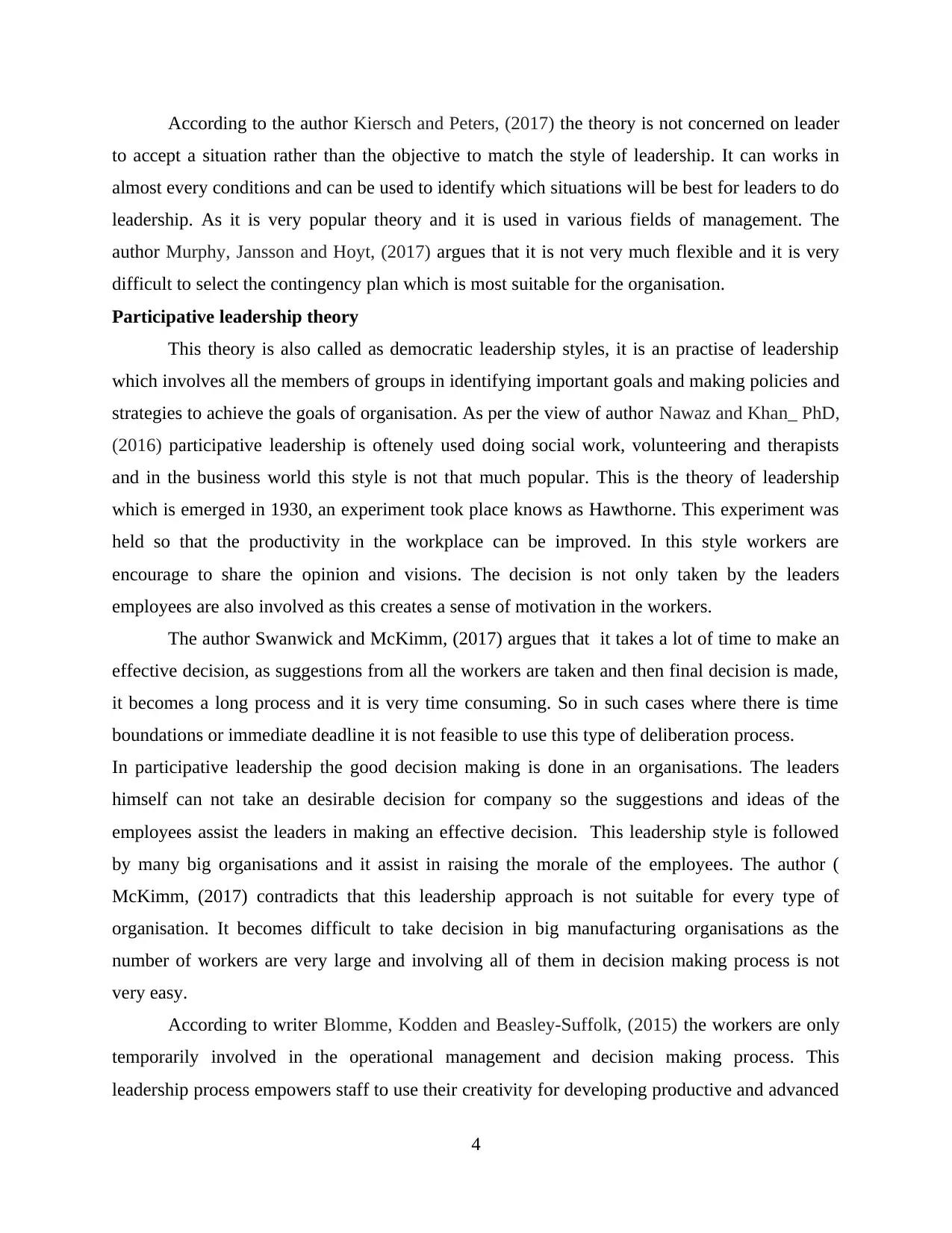
According to the author Kiersch and Peters, (2017) the theory is not concerned on leader
to accept a situation rather than the objective to match the style of leadership. It can works in
almost every conditions and can be used to identify which situations will be best for leaders to do
leadership. As it is very popular theory and it is used in various fields of management. The
author Murphy, Jansson and Hoyt, (2017) argues that it is not very much flexible and it is very
difficult to select the contingency plan which is most suitable for the organisation.
Participative leadership theory
This theory is also called as democratic leadership styles, it is an practise of leadership
which involves all the members of groups in identifying important goals and making policies and
strategies to achieve the goals of organisation. As per the view of author Nawaz and Khan_ PhD,
(2016) participative leadership is oftenely used doing social work, volunteering and therapists
and in the business world this style is not that much popular. This is the theory of leadership
which is emerged in 1930, an experiment took place knows as Hawthorne. This experiment was
held so that the productivity in the workplace can be improved. In this style workers are
encourage to share the opinion and visions. The decision is not only taken by the leaders
employees are also involved as this creates a sense of motivation in the workers.
The author Swanwick and McKimm, (2017) argues that it takes a lot of time to make an
effective decision, as suggestions from all the workers are taken and then final decision is made,
it becomes a long process and it is very time consuming. So in such cases where there is time
boundations or immediate deadline it is not feasible to use this type of deliberation process.
In participative leadership the good decision making is done in an organisations. The leaders
himself can not take an desirable decision for company so the suggestions and ideas of the
employees assist the leaders in making an effective decision. This leadership style is followed
by many big organisations and it assist in raising the morale of the employees. The author (
McKimm, (2017) contradicts that this leadership approach is not suitable for every type of
organisation. It becomes difficult to take decision in big manufacturing organisations as the
number of workers are very large and involving all of them in decision making process is not
very easy.
According to writer Blomme, Kodden and Beasley-Suffolk, (2015) the workers are only
temporarily involved in the operational management and decision making process. This
leadership process empowers staff to use their creativity for developing productive and advanced
4
to accept a situation rather than the objective to match the style of leadership. It can works in
almost every conditions and can be used to identify which situations will be best for leaders to do
leadership. As it is very popular theory and it is used in various fields of management. The
author Murphy, Jansson and Hoyt, (2017) argues that it is not very much flexible and it is very
difficult to select the contingency plan which is most suitable for the organisation.
Participative leadership theory
This theory is also called as democratic leadership styles, it is an practise of leadership
which involves all the members of groups in identifying important goals and making policies and
strategies to achieve the goals of organisation. As per the view of author Nawaz and Khan_ PhD,
(2016) participative leadership is oftenely used doing social work, volunteering and therapists
and in the business world this style is not that much popular. This is the theory of leadership
which is emerged in 1930, an experiment took place knows as Hawthorne. This experiment was
held so that the productivity in the workplace can be improved. In this style workers are
encourage to share the opinion and visions. The decision is not only taken by the leaders
employees are also involved as this creates a sense of motivation in the workers.
The author Swanwick and McKimm, (2017) argues that it takes a lot of time to make an
effective decision, as suggestions from all the workers are taken and then final decision is made,
it becomes a long process and it is very time consuming. So in such cases where there is time
boundations or immediate deadline it is not feasible to use this type of deliberation process.
In participative leadership the good decision making is done in an organisations. The leaders
himself can not take an desirable decision for company so the suggestions and ideas of the
employees assist the leaders in making an effective decision. This leadership style is followed
by many big organisations and it assist in raising the morale of the employees. The author (
McKimm, (2017) contradicts that this leadership approach is not suitable for every type of
organisation. It becomes difficult to take decision in big manufacturing organisations as the
number of workers are very large and involving all of them in decision making process is not
very easy.
According to writer Blomme, Kodden and Beasley-Suffolk, (2015) the workers are only
temporarily involved in the operational management and decision making process. This
leadership process empowers staff to use their creativity for developing productive and advanced
4
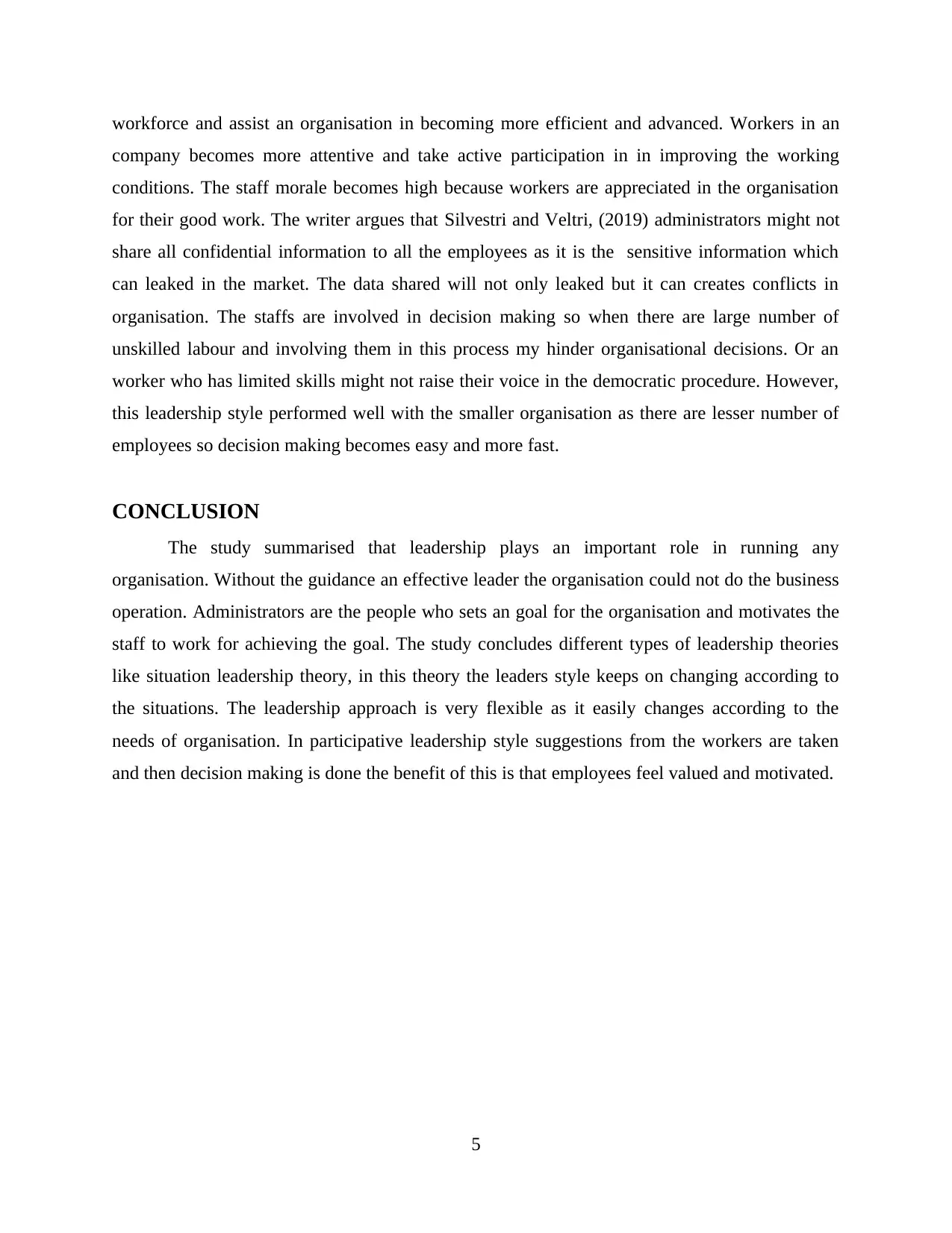
workforce and assist an organisation in becoming more efficient and advanced. Workers in an
company becomes more attentive and take active participation in in improving the working
conditions. The staff morale becomes high because workers are appreciated in the organisation
for their good work. The writer argues that Silvestri and Veltri, (2019) administrators might not
share all confidential information to all the employees as it is the sensitive information which
can leaked in the market. The data shared will not only leaked but it can creates conflicts in
organisation. The staffs are involved in decision making so when there are large number of
unskilled labour and involving them in this process my hinder organisational decisions. Or an
worker who has limited skills might not raise their voice in the democratic procedure. However,
this leadership style performed well with the smaller organisation as there are lesser number of
employees so decision making becomes easy and more fast.
CONCLUSION
The study summarised that leadership plays an important role in running any
organisation. Without the guidance an effective leader the organisation could not do the business
operation. Administrators are the people who sets an goal for the organisation and motivates the
staff to work for achieving the goal. The study concludes different types of leadership theories
like situation leadership theory, in this theory the leaders style keeps on changing according to
the situations. The leadership approach is very flexible as it easily changes according to the
needs of organisation. In participative leadership style suggestions from the workers are taken
and then decision making is done the benefit of this is that employees feel valued and motivated.
5
company becomes more attentive and take active participation in in improving the working
conditions. The staff morale becomes high because workers are appreciated in the organisation
for their good work. The writer argues that Silvestri and Veltri, (2019) administrators might not
share all confidential information to all the employees as it is the sensitive information which
can leaked in the market. The data shared will not only leaked but it can creates conflicts in
organisation. The staffs are involved in decision making so when there are large number of
unskilled labour and involving them in this process my hinder organisational decisions. Or an
worker who has limited skills might not raise their voice in the democratic procedure. However,
this leadership style performed well with the smaller organisation as there are lesser number of
employees so decision making becomes easy and more fast.
CONCLUSION
The study summarised that leadership plays an important role in running any
organisation. Without the guidance an effective leader the organisation could not do the business
operation. Administrators are the people who sets an goal for the organisation and motivates the
staff to work for achieving the goal. The study concludes different types of leadership theories
like situation leadership theory, in this theory the leaders style keeps on changing according to
the situations. The leadership approach is very flexible as it easily changes according to the
needs of organisation. In participative leadership style suggestions from the workers are taken
and then decision making is done the benefit of this is that employees feel valued and motivated.
5
Paraphrase This Document
Need a fresh take? Get an instant paraphrase of this document with our AI Paraphraser
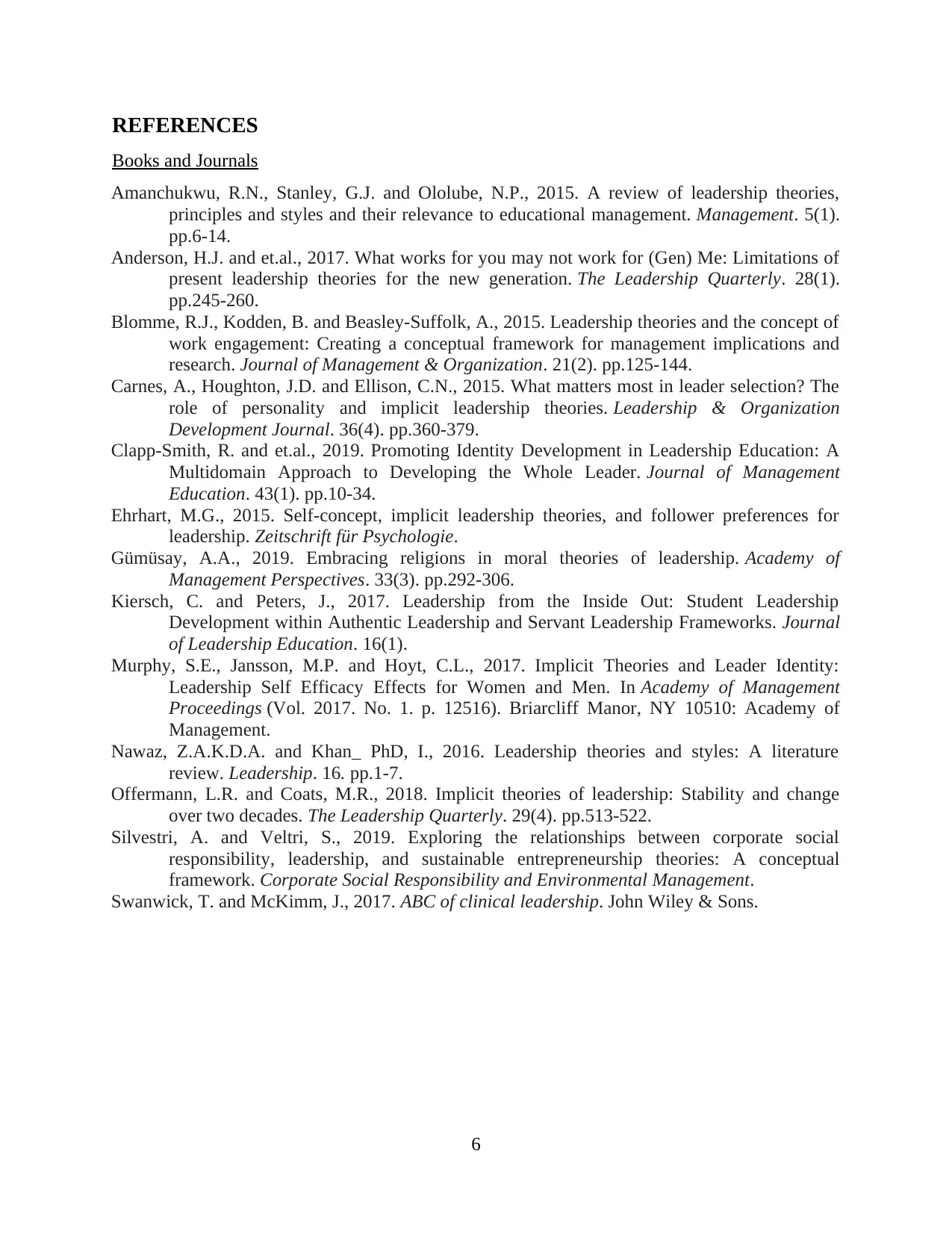
REFERENCES
Books and Journals
Amanchukwu, R.N., Stanley, G.J. and Ololube, N.P., 2015. A review of leadership theories,
principles and styles and their relevance to educational management. Management. 5(1).
pp.6-14.
Anderson, H.J. and et.al., 2017. What works for you may not work for (Gen) Me: Limitations of
present leadership theories for the new generation. The Leadership Quarterly. 28(1).
pp.245-260.
Blomme, R.J., Kodden, B. and Beasley-Suffolk, A., 2015. Leadership theories and the concept of
work engagement: Creating a conceptual framework for management implications and
research. Journal of Management & Organization. 21(2). pp.125-144.
Carnes, A., Houghton, J.D. and Ellison, C.N., 2015. What matters most in leader selection? The
role of personality and implicit leadership theories. Leadership & Organization
Development Journal. 36(4). pp.360-379.
Clapp-Smith, R. and et.al., 2019. Promoting Identity Development in Leadership Education: A
Multidomain Approach to Developing the Whole Leader. Journal of Management
Education. 43(1). pp.10-34.
Ehrhart, M.G., 2015. Self-concept, implicit leadership theories, and follower preferences for
leadership. Zeitschrift für Psychologie.
Gümüsay, A.A., 2019. Embracing religions in moral theories of leadership. Academy of
Management Perspectives. 33(3). pp.292-306.
Kiersch, C. and Peters, J., 2017. Leadership from the Inside Out: Student Leadership
Development within Authentic Leadership and Servant Leadership Frameworks. Journal
of Leadership Education. 16(1).
Murphy, S.E., Jansson, M.P. and Hoyt, C.L., 2017. Implicit Theories and Leader Identity:
Leadership Self Efficacy Effects for Women and Men. In Academy of Management
Proceedings (Vol. 2017. No. 1. p. 12516). Briarcliff Manor, NY 10510: Academy of
Management.
Nawaz, Z.A.K.D.A. and Khan_ PhD, I., 2016. Leadership theories and styles: A literature
review. Leadership. 16. pp.1-7.
Offermann, L.R. and Coats, M.R., 2018. Implicit theories of leadership: Stability and change
over two decades. The Leadership Quarterly. 29(4). pp.513-522.
Silvestri, A. and Veltri, S., 2019. Exploring the relationships between corporate social
responsibility, leadership, and sustainable entrepreneurship theories: A conceptual
framework. Corporate Social Responsibility and Environmental Management.
Swanwick, T. and McKimm, J., 2017. ABC of clinical leadership. John Wiley & Sons.
6
Books and Journals
Amanchukwu, R.N., Stanley, G.J. and Ololube, N.P., 2015. A review of leadership theories,
principles and styles and their relevance to educational management. Management. 5(1).
pp.6-14.
Anderson, H.J. and et.al., 2017. What works for you may not work for (Gen) Me: Limitations of
present leadership theories for the new generation. The Leadership Quarterly. 28(1).
pp.245-260.
Blomme, R.J., Kodden, B. and Beasley-Suffolk, A., 2015. Leadership theories and the concept of
work engagement: Creating a conceptual framework for management implications and
research. Journal of Management & Organization. 21(2). pp.125-144.
Carnes, A., Houghton, J.D. and Ellison, C.N., 2015. What matters most in leader selection? The
role of personality and implicit leadership theories. Leadership & Organization
Development Journal. 36(4). pp.360-379.
Clapp-Smith, R. and et.al., 2019. Promoting Identity Development in Leadership Education: A
Multidomain Approach to Developing the Whole Leader. Journal of Management
Education. 43(1). pp.10-34.
Ehrhart, M.G., 2015. Self-concept, implicit leadership theories, and follower preferences for
leadership. Zeitschrift für Psychologie.
Gümüsay, A.A., 2019. Embracing religions in moral theories of leadership. Academy of
Management Perspectives. 33(3). pp.292-306.
Kiersch, C. and Peters, J., 2017. Leadership from the Inside Out: Student Leadership
Development within Authentic Leadership and Servant Leadership Frameworks. Journal
of Leadership Education. 16(1).
Murphy, S.E., Jansson, M.P. and Hoyt, C.L., 2017. Implicit Theories and Leader Identity:
Leadership Self Efficacy Effects for Women and Men. In Academy of Management
Proceedings (Vol. 2017. No. 1. p. 12516). Briarcliff Manor, NY 10510: Academy of
Management.
Nawaz, Z.A.K.D.A. and Khan_ PhD, I., 2016. Leadership theories and styles: A literature
review. Leadership. 16. pp.1-7.
Offermann, L.R. and Coats, M.R., 2018. Implicit theories of leadership: Stability and change
over two decades. The Leadership Quarterly. 29(4). pp.513-522.
Silvestri, A. and Veltri, S., 2019. Exploring the relationships between corporate social
responsibility, leadership, and sustainable entrepreneurship theories: A conceptual
framework. Corporate Social Responsibility and Environmental Management.
Swanwick, T. and McKimm, J., 2017. ABC of clinical leadership. John Wiley & Sons.
6

7

8
Secure Best Marks with AI Grader
Need help grading? Try our AI Grader for instant feedback on your assignments.

9

10
1 out of 12
Related Documents
Your All-in-One AI-Powered Toolkit for Academic Success.
+13062052269
info@desklib.com
Available 24*7 on WhatsApp / Email
![[object Object]](/_next/static/media/star-bottom.7253800d.svg)
Unlock your academic potential
© 2024 | Zucol Services PVT LTD | All rights reserved.





